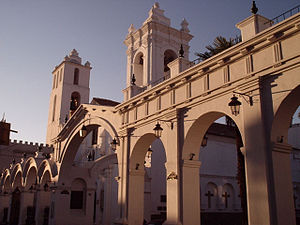
Sucre
Did you know...
Arranging a Wikipedia selection for schools in the developing world without internet was an initiative by SOS Children. Click here to find out about child sponsorship.
| Sucre Charcas La Plata, Chuquisaca |
|||
|---|---|---|---|
| Panorama of the Historic City of Sucre. | |||
|
|||
| Nickname(s): The White City, City of the 4 Names | |||
|
|
|||
| Coordinates: 19°2′2.04″S 65°15′45.36″W | |||
| Country | Bolivia | ||
| Departament | Chuquisaca | ||
| Province | Oropeza Province | ||
| Founded | September 29 1539 | ||
| Government | |||
| • Mayor | Aydeé Nava | ||
| Elevation | 2,750 m (9,020 ft) | ||
| Population (2006) | |||
| • Total | 225 000 | ||
| Time zone | GMT -4 | ||
| Area code(s) | 4 | ||
| Website | www.hamsucre.gov.bo/ | ||
| Historic City of Sucre | |
|---|---|
| Name as inscribed on the World Heritage List | |
 |
|
| Country | |
| Type | Cultural |
| Criteria | iv |
| UNESCO region | Latin America and the Caribbean |
Sucre (population 247,300 in 2006) is the constitutional capital of Bolivia, seat of the Supreme Court (Corte Suprema de Justicia), and capital of the Chuquisaca department. Located in the south-central part of the country, Sucre lies at an altitude of 2750m (9,000ft). Its lower altitude gives the city a warm temperate climate year-round.
On November 30 1538 Sucre was founded under the name Ciudad de la Plata de la Nueva Toledo by Pedro Anzures, Marqués de Campo Redondo. In 1538 the Spanish King Philip II established the Audiencia de Charcas in La Plata with authority over an area which covers what is now Paraguay, southeastern Peru, Northern Chile and Argentina, and much of Bolivia. The Audiencia de Charcas was a subdivision of the Viceroyalty of Peru. In 1601 the Recoleta Monastery was founded by the Franciscans and in 1609, an archbishopric was founded in the city. In 1624, St Francis Xavier University of Chuquisaca was founded.
Very much a Spanish city during the colonial era, the narrow streets of the city centre are organised in a grid, reflecting the Andalusian culture that is embodied in the architecture of the city's great houses and numerous convents and churches. Sucre remains the seat of the Catholic church in Bolivia, and a common sight is members of religious orders dressed in traditional costume. For much of its colonial history, Sucre's temperate climate was preferred by the Spanish royalty and wealthy families involved in silver trade coming from Potosí. Testament to this is the Glorieta Castle. Sucre's University (Universidad Real & Pontifice de San Francisco Xavier de Chuquisaca) is one of the oldest universities in the new world.
Until the 19th century, La Plata was the judicial, religious and cultural centre of the region. In 1839, after the city became the capital of Bolivia, it was renamed in honour of the revolutionary leader Antonio José de Sucre. Too remote after the economic decline of Potosí and its silver industry, it saw the Bolivian seat of government move to La Paz in 1898. Many argue Sucre was the epicenter that initiated the independence campaign against Spain in all of Latin America. The first "Grito Libertario" (Shout for Freedom) in any Western Hemisphere Spanish colony of took place in Sucre in 1809. Ironically, Bolivia was the last territory to gain its independence in 1825. In 1991, Sucre became a UNESCO World Heritage Site.
The city attracts thousands of tourists every year thanks to its well-conserved downtown with buildings from the 18th and 19th centuries. Nestled at the foot of the twin hills of Churuquella and Sika Sika, Sucre is the gateway to numerous small villages that date from the colonial era, the most well-known of which is Tarabuco, home of the colorful " Pujllay" festival held each March. Most of these villagers are members of one of the indigenous ethnicities. Many dress in clothing distinctive to their respective villages.
The City of Four Names
Sucre is also called “The City of Four Names”. Each of the well known names represent a specific era of the city's history.
- Charcas was the indigenous name for the place upon which the Spaniards built the colonial city.
- La Plata was the name given to the emerging Hispanic city of privilege and honour.
- The name Chuquisaca was bestowed upon the city during the independence era.
- Sucre honours the great marshal of the Battle of Ayacucho (December 9, 1824), Don Antonio Jose de Sucre.




